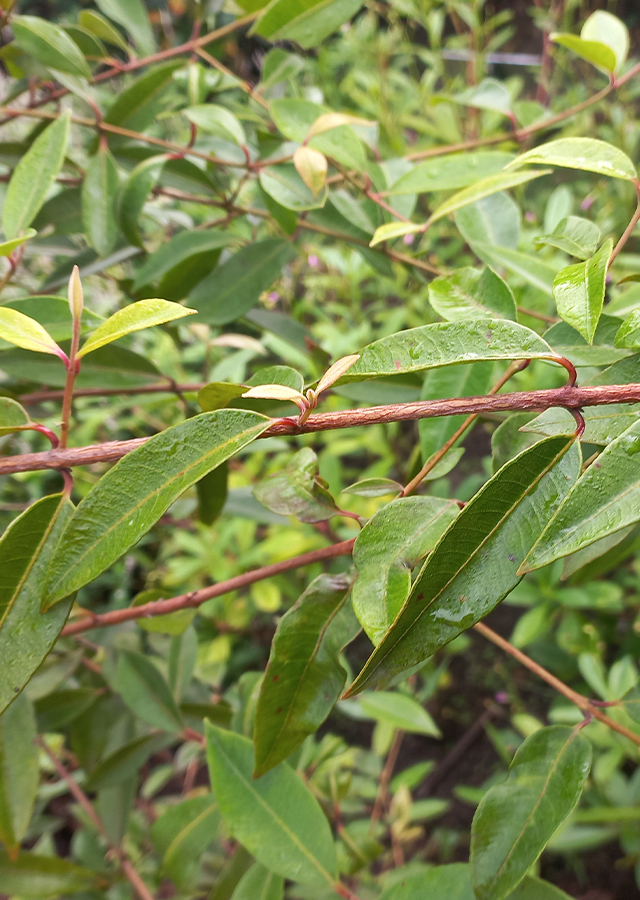Traditional Herbs from Backhousia citriodora
sore_throat
- Prepare fresh lemon myrtle leaves, wash them thoroughly.
- Soak them in water, wait for some time.
- Strain and gargle to soothe a sore throat.
What is Backhousia citriodora Looks like??



Parts of Backhousia citriodora that could be used
- Leaf
Backhousia citriodora Distribution
Lemon myrtle is endemic to the subtropical rainforests of central and southeast Queensland, Australia, with a natural distribution from Mackay to Brisbane. The leaves contain essential oil with a high citral content, which is used in perfumes and soaps and as a flavoring. The oil resembles lemongrass oil, but is said to be of better quality (e.g., contains no fat) and higher yields. Fresh and dried leaves can be used as a food seasoning. According to research, lemon myrtle essential oil also has antimicrobial activity.Agroecology of Backhousia citriodora
Lemon myrtle is a plant from subtropical to tropical zones, and is also able to grow well in frost-free climates. Mature plants can tolerate some frost, but younger plants need protection. The plant grows naturally in areas with rainfall of 800 mm or more per year. Prefers moist but well-drained fertile soil and a position in full sun. Once large/vigorous plants tolerate all but the poorest drained soils. Requires circumneutral soil and is susceptible to yellowing in alkaline conditions. Established plants are fairly drought tolerant. Plants need protection from strong winds because they can easily break at the base of the stem.
Morphology of Backhousia citriodora
- Taproot.
- Woody stem.
- Leaves opposite, coriaceous,\u00a0petiole up to 1.5 cm long, blade ovate-lanceolate, 7.5-12.5 cm long.
- Flowers with inflorescence is an axillary cyme, like an umbel with a cluster of many small flowers at the end of the branch, peduncle 2.5-3 cm long, pedicel longer than 1 cm. Petals tubular, shaped wide circle, 4 lobes,\u00a04 petals, shorter than the calyx lobes,\u00a0pistil with 2 ovaries, each locule with 6-8 pendulous ovules, pistil stalk (style) filiform, small stigma.
- Fruit capsule does not break , surrounded by persistent petals.
Cultivation of Backhousia citriodora
- Propagation can be done generatively (seeds) and vegetatively (stem cuttings and separation of seedlings from the parent).
- Propagation by seed is difficult because\u00a0it is difficult to germinate. Sow into damp media, place the seed tray in almost half the depth of water clean and maintain a temperature of around 16 - 18 C. The seedlings will take about 12 months to fully develop. When the seedlings are about 5 mm high, remove the tray from the water, leave it for 4 - 5 days and then plant the seedlings into separate containers.
- For cuttings use half-ripe wood, but they are slow to root and the small lower branches often touch the ground and form roots. These can be separated from the parent plant, and planted elsewhere.
Backhousia citriodora, more details :
Chemical Content of Backhousia citriodoraEssential oils (citral A, citral B, B-Myrcene, lynalool, citronellal, iso-neral, iso-geranial, trans-geraniol).
Benefits of Backhousia citriodora
Lemon myrtle has a reputation as a powerful antiseptic and antiviral agent that can destroy disease-carrying microorganisms. It has been used to treat allergies, colds, sore throats, stomach disorders and infections, relieve headaches, fever, muscle cramps and spasms, promote a healthy immune system, treat problems such as warts, cold sores, and acne. Has activity is a very powerful antioxidant that can help fight diseases such as cancer.
Simplisia of Backhousia citriodora
- Prepare lemon myrtle leaves, wash thoroughly with running water then drain.
- Dry in the sun or in an oven at\u00a040\u00b0C until the water content\u00a010%.
- Choose using a blender until it becomes powder.", "Store in a clean and airtight place.
Another Facts for Backhousia citriodora :
Synonym of Backhousia citriodora-
Habitus of Backhousia citriodora
Bush. Annual shrub or small tree, 5 m high
Habitat of Backhousia citriodora
- Forest
No comments:
Post a Comment